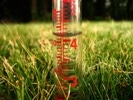
Seed companies report soybean yields in some plot somewhere of either 80 or even 90 bushels per acre almost every season. But doing it across a whole field and doing it consistently is the trick. This may be a tough year for that to happen in Indiana. Rains dried up in august, a critical period for soybean development.
"We've have hit 70 bushels per acre on a couple fields of early planted beans with one timely rain in August," one central Indiana farmer says. As it was, his no-till beans on better ground ran in the high 50 per bushel range.
A common observation seems to be that early-planted beans, going back to mid-April, had lots of pods, but the beans inside the pods are smaller than normal.
What remains to be seen is how soybeans that were planted during the second wave of planting, in late May, stack up. In theory, they might have hit their reproductive period when it was already dry.
In 2008 very late-planted soybeans, into late June, yielded well, some over 50 bushels per acre, thanks to timely rains and a long fall before frost. It was a year where the theory that soybeans planted after late May don't yield well didn't hold up. Will this year be the opposite side of the scale?
Major problems with soybean diseases and insects haven't been reported. Japanese beetles did some traditional feeding in July, but they are top feeders. Their bark is usually worse than their bite. Even though a few leaves may be heavily damaged, the overall leaf loss on the entire plant is often well below economic thresholds, even at key stages for plant development.
Sudden death syndrome was noted in some fields, especially in southern Indiana. However, it's usually worse in wetter seasons. Few reports of white mold have surfaced so far. It's also favored by seasons with more moisture. Some have switched back to 30-inch rows in areas where white mold has been particularly bad over the past few seasons. It tends to do less damage if the canopy isn't as dense. The trade-off is the yield benefit of narrower rows.
Purdue Extension staff confirm that Asian rust is not a factor in Indiana again this year. Rumored to be a serious threat as long as five years ago, this potentially significant disease has yet to get a strong foothold even in southern states. It can't survive winters this far north, so inoculum that comes in now would not be a concern for next year. It overwinters on kudzu, much more prevalent in the south. A small amount of kudzu reportedly overwinters in Indiana, but it's insignificant.
About the Author(s)
You May Also Like




